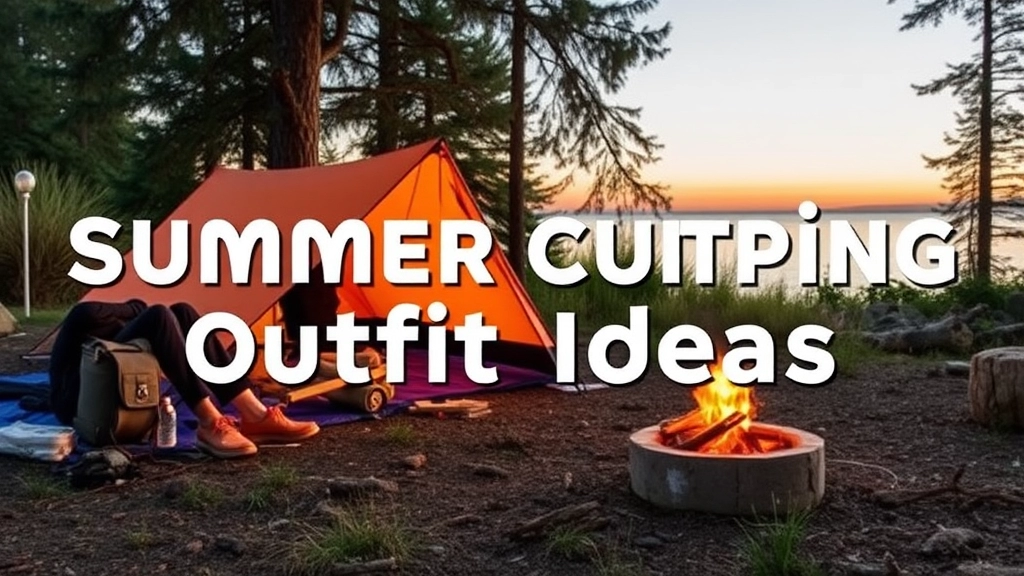Summer Camping Outfit Ideas
Summer camping is an exhilarating experience, but it can quickly turn uncomfortable if you’re not dressed appropriately. This article delves into essential summer camping outfit ideas to keep you cool, comfortable, and stylish. From lightweight, breathable tops to versatile bottoms and protective footwear, we’ve got you covered. We’ll also discuss the importance of layering for those chilly summer nights and the best accessories for sun protection and style.
Practical Tips for Your Camping Wardrobe
Whether you’re hiking rugged trails, lounging by the lake, or transitioning from day to night, this guide offers practical tips and real-life examples to help you pack smart and stay comfortable. Learn about eco-friendly and durable materials that are perfect for outdoor wear, and discover how to mix and match your outfits for maximum versatility.
Ready for Adventure?
Ready to elevate your camping wardrobe? Let’s dive in and make your next summer camping trip a stylish and comfortable adventure!
Essential Summer Camping Outfit Basics
Alright, so you’re gearing up for some summer camping, huh? Let’s cut to the chase â what should you wear to stay comfy and cool while still being prepared for whatever nature throws at you?
Real Questions and Worries
Ever been out camping and found yourself either sweating buckets or shivering as the sun goes down? Or maybe you’ve packed all wrong and ended up lugging around a ton of stuff you didn’t even need? Yeah, we’ve all been there. So, let’s break it down and get you sorted.
Why Getting the Basics Right Matters
When it comes to summer camping, the right outfit can make or break your experience. You want to be:
- Comfortable: No one likes chafing or feeling sticky.
- Protected: From the sun, bugs, and sudden weather changes.
- Prepared: For different activities like hiking, swimming, or just chilling by the campfire.
Core Elements of a Summer Camping Wardrobe
Lightweight and Breathable Tops
You’re going to need tops that let your skin breathe. Think moisture-wicking fabrics that keep you dry and cool. Cotton might feel nice, but it holds onto sweat â not ideal for a long day out.
- T-Shirts: Go for synthetic blends or merino wool.
- Tank Tops: Great for layering or wearing solo.
Shorts vs. Leggings
Choosing between shorts and leggings depends on your activity and comfort level.
- Shorts: Perfect for hot days and casual strolls.
- Leggings: Great for hikes, offering protection from bugs and rough terrain.
Layering for Summer Nights
Even in summer, nights can get chilly. Be prepared with:
- Sweaters: Lightweight and easy to pack.
- Hoodies: Adds an extra layer of warmth and comfort.
- Light Jackets: Windbreakers or waterproof options are ideal.
Footwear for All Adventures
Your feet are going to take a beating, so make sure you have the right shoes.
- Hiking Boots: Essential for any serious trekking.
- Sneakers: Good for lighter activities.
- Sandals: Perfect for lounging or water activities.
Hats and Accessories
Sun protection is non-negotiable.
- Hats: Wide-brimmed for full coverage.
- Sunglasses: Protect your eyes from UV rays.
- Bandanas: Multi-functional â use them for sweat, sun protection, or even as a makeshift mask.
Packing Tips
When packing, think about versatility and durability. Your clothes are going to get dirty and possibly wet.
- Quick-Dry Fabrics: These will save you a lot of hassle.
- Multi-Use Items: A scarf that can be a blanket, a jacket that doubles as a pillow.
- Eco-Friendly Materials: Opt for sustainable options that can withstand the elements.
Keep It Real, Keep It Fresh
Look, camping is supposed to be fun and freeing. Don’t overthink it â just make sure you’ve got the essentials covered. Remember, it’s all about comfort, protection, and being prepared for whatever comes your way. So, pack smart, dress right, and enjoy the great outdoors!
If you’re looking for more tips on how to stay cool and comfy, check out our summer camping outfit essentials. And for those who want to dive deeper into the various types of camps available, don’t miss our ultimate guide to summer camps.
Lightweight and Breathable Tops for Hot Weather
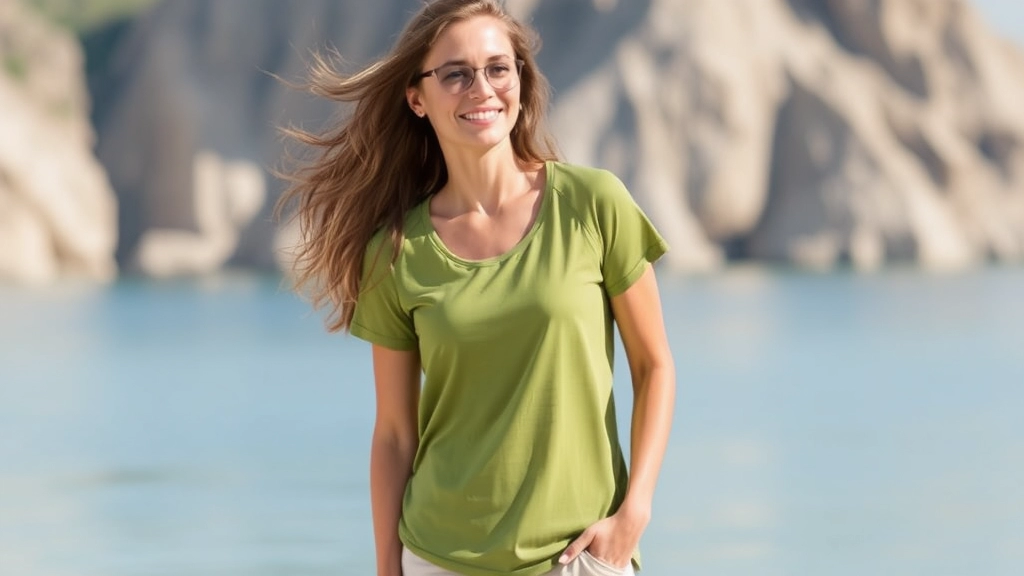
Ever been out camping in the summer, feeling like you’re melting under the sun?
Yeah, we’ve all been there.
Finding the right tops for hot weather can make or break your camping experience.
You need something that’s lightweight and breathable, but also stylish enough to feel good wearing.
Here’s what you should look for:
Material Matters
- Cotton: Soft and comfy, but not the best for wicking away sweat.
- Polyester: Great for moisture-wicking, but can sometimes feel a bit plastic-y.
- Merino Wool: Surprisingly breathable and keeps you cool, but can be pricey.
- Bamboo: Eco-friendly and super soft, plus it’s great for sensitive skin.
Fit and Style
- Loose Fit: Allows air to circulate, keeping you cooler.
- Tank Tops: Perfect for ultimate breathability.
- Short Sleeves: A good balance between sun protection and ventilation.
- Button-Ups: Versatile and can be dressed up or down.
Features to Look For
- Moisture-Wicking: Keeps you dry by pulling sweat away from your skin.
- Quick-Drying: Essential for those unexpected rain showers or river dips.
- UV Protection: Some tops come with built-in SPF to shield you from harmful rays.
- Anti-Odour: Keeps you smelling fresh, even after a long day of activities.
Personal Picks
When I hit the trails, I swear by my moisture-wicking polyester tank top.
It’s light, dries fast, and I don’t feel like I’m wearing a plastic bag.
For those cooler mornings, a loose-fitting, short-sleeve merino wool shirt does the trick.
Real Life Example
Last summer, I went camping in the Lake District.
The weather was scorching.
My mate wore a tight cotton tee, and by midday, he was drenched and miserable.
Meanwhile, I was cool and dry in my bamboo tank top.
Lesson learned: Material and fit matter.
Quick Tips
- Pack a variety: Mix tank tops, short sleeves, and a button-up.
- Layering: Always have a lightweight long-sleeve for added sun protection.
- Colour Choices: Lighter colours reflect heat, keeping you cooler.
Internal Links
- Check out our guide on Layering for Summer Nights to stay warm after the sun sets.
- For more on eco-friendly options, see our section on Eco-Friendly and Durable Materials for Outdoor Wear.
Shorts vs. Leggings: Choosing the Right Bottoms for Comfort
Alright, let’s get real. When it comes to summer camping, the last thing you want is to be uncomfortable. So, shorts vs. leggingsâwhich is the right choice? You’ve got questions, and I’ve got answers.
What’s the Deal with Shorts?
Shorts are the go-to for many campers when the weather heats up. They’re breathable, lightweight, and perfect for keeping cool. But here’s the kicker: not all shorts are created equal.
Pros:
- Breathability: Keeps you cool in the scorching sun.
- Freedom: Easier movement for activities like hiking or setting up camp.
- Quick Drying: Ideal if you’re near water or expect a surprise rain shower.
Cons:
- Exposure: Legs are exposed to bugs, plants, and the sun.
- Chafing: Without the right fit, you might experience some discomfort.
Tip: Look for shorts made of moisture-wicking material to keep sweat at bay. Also, consider cargo shorts for extra storage.
Leggings: The Unsung Hero
Now, let’s talk leggings. You might think they’re just for yoga, but they’re actually a solid choice for camping too.
Pros:
- Protection: Covers your legs, shielding them from bugs and sunburn.
- Comfort: Stretchy and snug, they move with you.
- Versatility: Great for both daytime hikes and chilly nights around the campfire.
Cons:
- Heat: Can get warm during the day if they’re not breathable.
- Limited Pockets: Most leggings don’t offer much in the way of storage.
Tip: Opt for leggings with a high UPF rating for sun protection and moisture-wicking fabric to stay cool.
Shorts vs. Leggings: The Showdown
Ultimately, the choice between shorts and leggings boils down to your personal preference and the activities you’ve got planned. Here’s a quick comparison to help you decide:
| Feature | Shorts | Leggings |
|---|---|---|
| Breathability | High | Moderate |
| Protection | Low | High |
| Comfort | High (if fitted well) | High |
| Versatility | Moderate | High |
| Storage | High (with cargo shorts) | Low |
My Personal Take
When I’m heading out for a summer camping trip, I like to pack both. Shorts for the hot, active days and leggings for the cooler evenings or when I need extra protection. It’s all about having options and being prepared.
So, what’s your preference? Whether you’re team shorts or team leggings, the key is to choose what makes you feel comfortable and ready for adventure.
And remember: Pack clothes that can handle getting dirty or wet. It’s camping, after all!
For more tips on preparing for your camping trip, check out our guide to summer camping gear and fun activities. If you’re looking for a comprehensive list of camps, don’t miss our ultimate guide to Greenville County summer camps.
Layering for Summer Nights: Sweaters, Hoodies, and Light Jackets
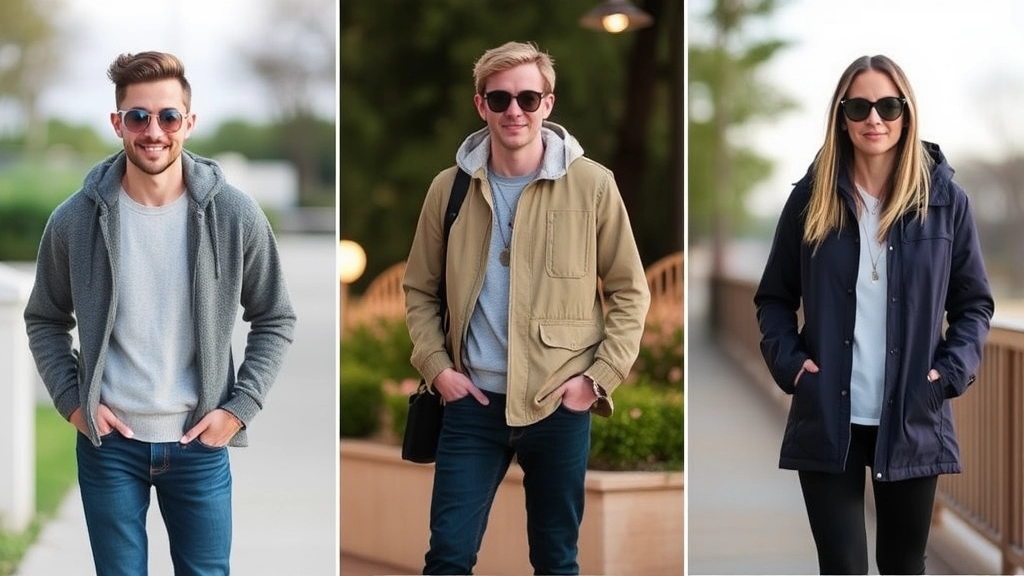
Ever been camping and found yourself shivering as soon as the sun dips below the horizon?
Yeah, me too.
Summer nights can be surprisingly chilly, even after a scorching day.
So, how do you stay warm without lugging around your winter gear?
Let’s dive in.
Why You Need Layers for Summer Nights
When it comes to camping, layering is your best mate.
Why?
Because temperatures can swing wildly from day to night.
You need to be ready for anything.
Essential Layers to Pack
Here’s what you’ll want to bring:
- Sweaters: Lightweight but warm. Think merino wool or cotton blends.
- Hoodies: Perfect for that casual, cosy feel. Plus, the hood can be a lifesaver if it gets windy.
- Light Jackets: Go for something water-resistant. You never know when a summer shower might hit.
Choosing the Right Materials
Not all fabrics are created equal.
Here’s what you should look for:
- Breathable fabrics: Keeps you from sweating buckets.
- Moisture-wicking: Helps you stay dry if you do break a sweat.
- Quick-drying: Because damp clothes are the worst.
Real Talk: My Go-To Layering Combo
When I head out for a summer camping trip, I stick to a simple formula:
- Base Layer: A moisture-wicking t-shirt.
- Mid Layer: A comfy hoodie. I love the ones with a kangaroo pocket for keeping my hands warm.
- Outer Layer: A light, packable jacket. Preferably something that can handle a bit of rain.
Pro Tips for Layering
A few more tips to keep you toasty:
- Pack a beanie: Your head loses heat fast. A beanie is small but mighty.
- Use layers you can mix and match: Versatility is key. You want pieces that work together in any combo.
- Don’t forget your feet: Warm socks can make a huge difference.
Stories from the Campfire
I once went camping in the Lake District, expecting balmy summer nights.
Big mistake.
The temperature dropped like a stone, and I was stuck with just a thin jumper.
Lesson learned: Always pack layers, even if the forecast looks warm.
Ready to layer up for your next adventure?
Don’t forget to check out our other tips on lightweight tops for hot weather and choosing the right bottoms for comfort.
Footwear for All Camping Adventures: From Hiking to Casual Strolls
Alright, let’s talk about one of the most critical aspects of your summer camping gear: footwear. Whether you’re hitting rugged trails or just taking a leisurely walk around the campsite, the right shoes can make or break your adventure.
Why Footwear Matters
Ever had to cut a hike short because your feet were killing you? Yeah, me too. The right pair of shoes can save you from blisters, sore arches, and even twisted ankles. So, let’s break down what you need to consider.
Hiking Boots: The Heavy Lifters
When it comes to serious hiking, you need boots that can handle rough terrain, provide ankle support, and keep your feet dry. Look for:
- Waterproof Material: Wet feet are a recipe for blisters.
- Ankle Support: Prevents sprains on uneven ground.
- Breathability: Keeps your feet cool and dry.
Pro Tip: Break in your hiking boots before your trip. Trust me, your feet will thank you.
Trail Runners: The Middle Ground
If you’re planning on a mix of hiking and casual strolling, trail runners are your best bet. They offer:
- Lightweight Design: Easier on your feet for long distances.
- Good Traction: Handles a variety of terrains.
- Breathable Fabric: Keeps your feet from overheating.
Example: I once switched to trail runners for a weekend camping trip and found them perfect for both the trails and the campsite.
Casual Shoes: For Easy Walks and Lounging
For those times when you’re just hanging out or taking a short walk, a pair of comfortable casual shoes will do the trick. Think:
- Slip-Ons or Sandals: Easy to put on and take off.
- Cushioned Soles: For extra comfort.
- Quick-Drying: Ideal if you’re near water.
Story Time: I always pack a pair of slip-on sandals for those midnight bathroom runs. Quick and easy!
Multi-Use Footwear: Versatility is Key
If you want to pack light, look for footwear that can do double duty. Some hiking sandals, for example, offer the support of a hiking shoe but are breathable like a sandal.
- Adjustable Straps: For a secure fit.
- Durable Soles: Can handle rough terrain.
- Water-Friendly: Perfect for river crossings or beach days.
Packing Tips for Footwear
When it comes to packing, less is more. Here’s how to make sure you’ve got the right shoes without overpacking:
- One Pair of Hiking Boots or Trail Runners: Depending on your main activity.
- One Pair of Casual Shoes or Sandals: For downtime.
- Extra Socks: Trust me, you’ll need them.
Quick Tip: Use your shoes to store small items like socks or toiletries to save space in your bag.
For more tips on preparing for your summer camp adventure, check out our Summer Camp Cabin Guide and don’t forget to browse through our Top Summer Camps in Maryland for some great camp options.
Hats and Accessories for Sun Protection and Style
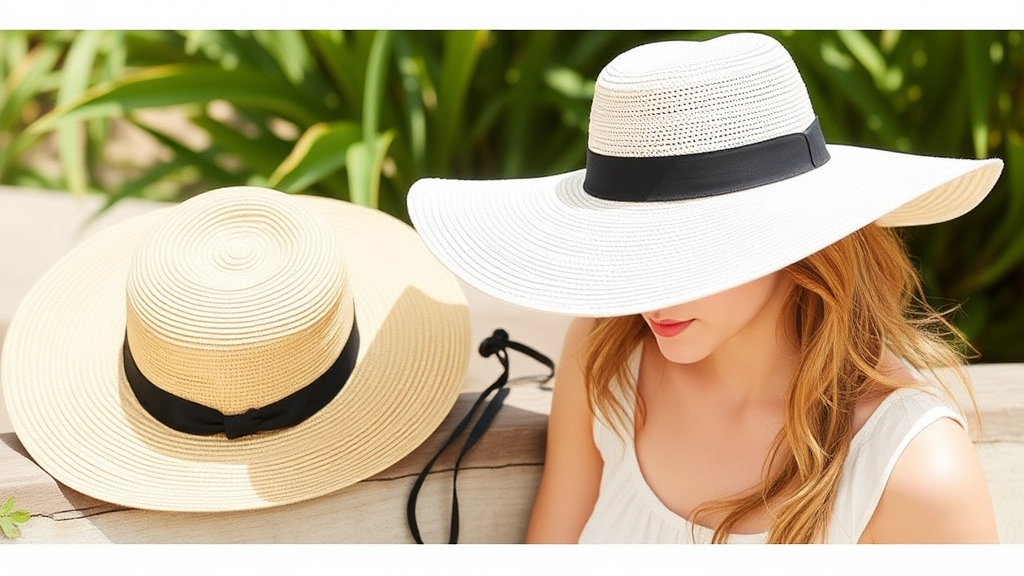
Alright, let’s talk hats and accessories for summer camping.
You know what’s worse than a sunburned scalp? Pretty much nothing.
Sun Protection is Key
When you’re out there, the sun’s not messing around.
Hats are non-negotiable.
- Wide-brimmed hats: Cover your face, neck, and ears. Think of those classic safari hats.
- Baseball caps: Good for a casual look, but don’t forget the sunscreen for your neck.
- Bucket hats: Trendy and practical. They give you 360-degree coverage.
Sunglasses
Ever tried squinting your way through a hike? Not fun.
- Polarised lenses: Reduce glare. Essential for water-based activities.
- Wraparound styles: Protect your eyes from all angles.
Bandanas and Buffs
These little pieces of fabric can be lifesavers.
- Bandanas: Wet them and wear around your neck for a cooling effect.
- Buffs: Versatile. Headband, neck gaiter, or even a face mask.
Accessories with Style
You want to look good in those camping photos, right?
- Statement earrings: Lightweight and won’t get in the way.
- Bracelets and anklets: Simple, durable, and add a touch of personality.
Real Talk
Ever been on a camping trip and realised you forgot your hat? I have. Ended up with a sunburn that made me look like a lobster. Not fun.
So, pack smart.
Quick Tips
- Choose breathable materials: Cotton, hemp, or moisture-wicking fabrics.
- Go for adjustable: Ensures a good fit, even if you swap hairstyles.
- Pack extras: Hats and sunglasses can easily get lost or damaged.
Functional Activewear for Hiking and Sports Activities
Ever been on a hike and thought, “Why did I wear this?” Yeah, me too. Choosing the right activewear for hiking and sports is crucial. You want gear that’s comfortable, durable, and makes you feel like you can conquer any trail. Let’s dive into what makes activewear functional and why it matters.
Why Activewear Matters
First off, activewear isn’t just a fashion statement. It’s about performance and comfort. When you’re out there hiking or engaging in sports, the last thing you want is to be bogged down by heavy or restrictive clothing. Let’s break down what you should look for:
Key Features of Functional Activewear
- Moisture-Wicking Fabrics: Keeps you dry by pulling sweat away from your skin. No one likes that sticky feeling.
- Breathability: Essential for those hot summer days. Look for mesh panels or ventilated designs.
- Flexibility: You need to move freely. Stretchy materials like spandex or elastane are your friends.
- Durability: Trails can be tough, so your gear needs to withstand a bit of rough and tumble.
Choosing the Right Pieces
Tops
- Quick-Dry Tees: Perfect for any activity. They dry fast and keep you cool.
- Long-Sleeve Options: Great for sun protection or cooler mornings. Look for UPF-rated materials.
Bottoms
- Convertible Trousers: These are genius. Zip off the legs when it gets hot, and you’ve got shorts.
- Running Shorts: Lightweight and ideal for short hikes or jogs.
Footwear
- Trail Shoes: Offer better grip and support than regular trainers.
- Hiking Boots: Necessary for tougher terrains. Make sure they’re broken in before a long trek.
Accessories to Consider
- Hydration Packs: Staying hydrated is key. These packs make it easy.
- Sun Hats: Protects your face and neck from harsh UV rays.
- Sunglasses: Polarised lenses reduce glare and protect your eyes.
Real Talk: What Works for Me
Once, I wore jeans on a hike. Big mistake. Now, I swear by my moisture-wicking gear. It’s like night and day. Also, I never hit the trails without my trusty trail shoes. They’ve saved my ankles more times than I can count.
Packing Tips for Activewear
- Roll, Don’t Fold: Saves space and reduces wrinkles.
- Pack Extras: Always have a spare tee and socks. You’ll thank me later.
Eco-Friendly Options
Want to be kind to the planet? Look for sustainable materials like recycled polyester or organic cotton. Brands are getting smarter about this, and it’s a win-win for everyone.
If you’re planning to hit the trails this summer, you might also want to check out some exciting summer camp activities to make your adventure even more enjoyable. And for those who love water sports, don’t miss our guide on summer camp swimming tips to stay safe and have fun.
Stylish Options for Lakeside or Beach Camping
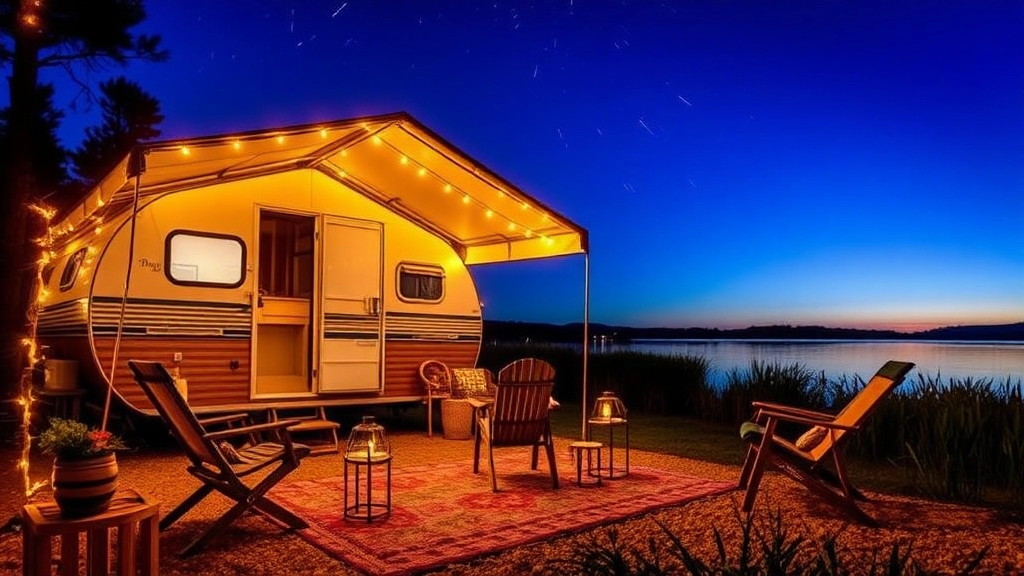
Ever wondered how to look stylish while camping by the lake or beach without overpacking?
Let’s dive right in.
Effortless Beach Chic
You want to look good but stay comfy. Here’s how:
- Flowy Dresses: Think light, airy, and easy to throw on.
- Swimwear: A chic swimsuit can double up as a top.
- Sarongs and Cover-ups: Perfect for transitioning from water to land.
Practical Yet Stylish Footwear
No one wants to lug around a suitcase full of shoes. Here’s what you need:
- Flip-Flops: Easy for quick dips.
- Water Shoes: Essential for rocky beaches.
- Casual Sneakers: Great for exploring nearby trails.
Accessories That Pop
Make your outfit stand out with a few key accessories:
- Wide-Brimmed Hats: Protects you from the sun and looks fab.
- Sunglasses: Choose a pair that complements your face shape.
- Beach Bags: Go for something stylish yet functional.
Versatile Outfits for Day and Night
You need outfits that can transition smoothly from day to night:
- Lightweight Cardigans: Perfect for cooler evenings.
- Maxi Dresses: Can be dressed up or down.
- Layered Jewellery: Adds a touch of glam without being over-the-top.
Real Talk: What You Actually Need
You don’t need a ton of clothes to look good. Focus on:
- Mix and Match: Choose pieces that can be paired in multiple ways.
- Quick-Dry Fabrics: Ideal for when you get wet.
- Comfortable Yet Stylish: You’re camping, not hitting a runway.
Pro Tips from the Field
I’ve been there, done that. Here are my top tips:
- Pack Light: Trust me, you won’t wear half the stuff you bring.
- Stay Practical: It’s about balancing style with comfort.
- Be Ready for Anything: Weather can change, so be prepared.
Transitioning from Day to Night with Versatile Outfits
Alright, let’s talk about a real camping dilemma: How do you transition your outfit from a sweaty day hike to a chill evening by the campfire without lugging around a wardrobe? Trust me, I’ve been there, and I know you don’t want to overpack. So, let’s break it down.
Why Versatile Outfits Matter
When you’re camping, space is limited. You need clothes that can handle the heat of the day and the cool of the night. Plus, who wants to spend time changing clothes when you could be roasting marshmallows?
Key Pieces for Day-to-Night Transitions
1. Convertible Pants:
- Why they rock: They zip off into shorts for daytime hikes and zip back on for evening chills.
- Pro tip: Look for lightweight, quick-dry fabric. No one likes soggy pants.
2. Layering Tops:
- Tank Tops and T-Shirts: Breathable, moisture-wicking materials are your best friends.
- Long-Sleeve Button-Ups: Perfect for sun protection during the day and a bit of warmth at night.
3. Lightweight Hoodies or Sweaters:
- Why you need them: Even summer nights can get nippy.
- Bonus: They double as pillows when you’re in a pinch.
4. Multi-Functional Footwear:
- Hiking Boots: Great for rugged terrain.
- Sandals or Slip-Ons: Ideal for lounging around the campsite.
Real Talk: How I Do It
When I camp, I stick to a simple formula. In the morning, I start with a moisture-wicking tank top and convertible pants. As the day heats up, I zip off the legs and roll up my sleeves. When the sun sets, I zip the legs back on and throw on a lightweight hoodie. Easy, right?
Practical Tips for Seamless Transitions
- Pack Neutral Colours: They mix and match easily.
- Invest in Quality: Durable materials last longer and perform better.
- Think Multi-Use: A bandana can be a headband, a neck warmer, or even a towel.
Why It Works
Versatile outfits save you space and hassle. They let you enjoy your camping trip without worrying about what to wear next. Plus, fewer clothes mean more room for essentials like food and gear.
For more tips on what to bring, check out our Ultimate Guide to Summer Camp Packing. And if you’re looking for activities to keep everyone entertained, don’t miss our Summer Camp Ideas for Fun Activities.
Packing Tips: Clothes That Can Get Dirty or Wet
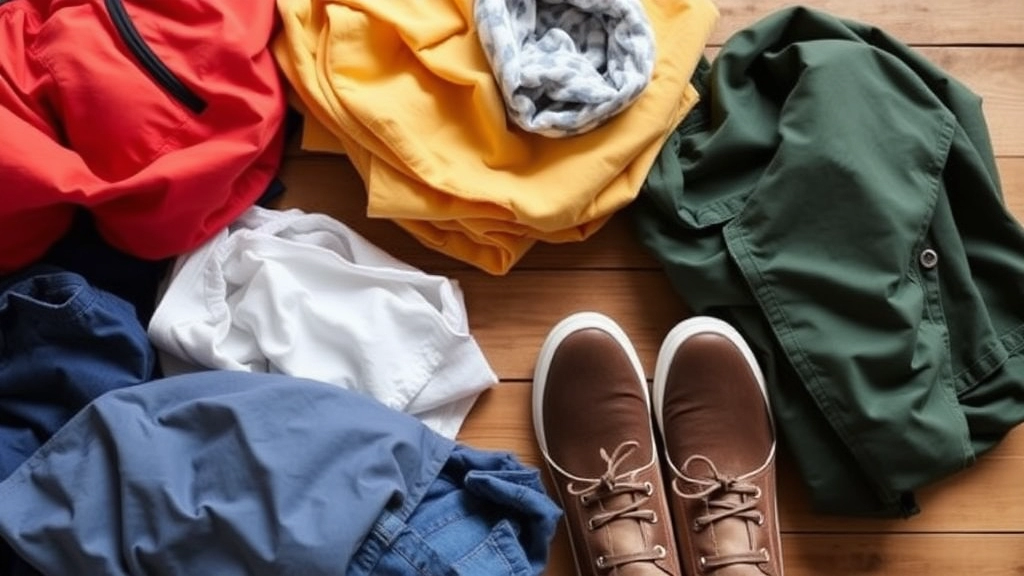
Ever been on a camping trip and realised you didn’t pack enough clothes for those muddy trails or unexpected rain showers?
Yeah, me too.
Here’s the deal: packing clothes that can get dirty or wet is a game-changer for any summer camping adventure.
Why You Need Them
When you’re out in nature, things get messy.
And that’s part of the fun, right?
But you don’t want to be caught off guard.
So, let’s dive into some tips to make sure you’re ready for anything.
Go for Quick-Dry Fabrics
First up, quick-dry fabrics are your best friend.
They help you stay comfortable even when things get wet.
Look for materials like:
- Nylon
- Polyester
- Merino wool (yes, even in summer!)
These fabrics wick away moisture and dry in a flash.
Pack Multiples
Don’t just pack one or two outfits and call it a day.
Bring extras.
Trust me.
You’ll thank yourself when you’ve got a fresh set of clothes to change into after a muddy hike.
Embrace the Dirt
It’s camping, not a fashion show.
So, pack clothes that you won’t mind getting dirty.
Old t-shirts, shorts, and leggings work great.
Waterproof Layers
A lightweight, waterproof jacket is a must.
Even if the forecast looks sunny, you never know when a surprise shower might hit.
Footwear Matters
Got wet feet?
Game over.
Pack waterproof hiking boots and an extra pair of shoes for lounging around the campsite.
Easy Laundry Hacks
Camping doesn’t mean you can’t wash your clothes.
Pack a small bottle of biodegradable soap and a portable clothesline.
Quick rinse, hang to dry, and you’re good to go.
Real Talk: My Muddy Adventure
Last summer, I went on a camping trip and forgot to pack extra clothes.
Big mistake.
One muddy hike later, I was stuck in soggy, dirty clothes for the rest of the day.
Learn from my mistake.
Pack smart.
Recap: Essentials for Dirty or Wet Conditions
- Quick-dry fabrics: Nylon, polyester, merino wool
- Multiples: Extra outfits
- Waterproof layers: Lightweight jacket
- Footwear: Waterproof boots, extra shoes
- Laundry hacks: Biodegradable soap, portable clothesline
Eco-Friendly and Durable Materials for Outdoor Wear
Ever wondered how to stay eco-friendly while camping?
What if I told you that you can enjoy the great outdoors without harming it?
Eco-friendly and durable materials are the way to go.
Let’s dive into why they matter and how to choose them.
Why Go Eco-Friendly?
First off, we all love nature, right?
So, why not protect it?
Eco-friendly materials reduce your carbon footprint.
They’re made from sustainable resources and often biodegradable.
Plus, they’re usually free from harmful chemicals.
The Durability Factor
Camping can be rough on your clothes.
You need something that lasts.
Durable materials mean fewer replacements.
That’s less waste and more savings.
Top Eco-Friendly Materials
Here are some of my favourites:
- Organic Cotton: Breathable and comfy. No nasty pesticides.
- Recycled Polyester: Keeps plastics out of landfills. Super durable.
- Hemp: Strong and gets softer with each wash. Plus, it’s naturally resistant to mould.
- Bamboo: Soft, moisture-wicking, and grows like a weed (literally).
Real Talk: What Works Best?
When I’m out camping, I look for a mix of these materials.
- For Tops: Organic cotton or bamboo.
- For Bottoms: Recycled polyester or hemp.
- For Outerwear: A blend of recycled materials.
What About Accessories?
Don’t forget the little things:
- Hats: Look for organic cotton or recycled materials.
- Socks: Bamboo or organic cotton for breathability.
- Backpacks: Recycled polyester is a solid choice.
Stories from the Trail
Last summer, I switched to a hemp shirt.
It survived a week of hiking, fishing, and even a surprise rainstorm.
No rips, no tears, and it felt great.
For more inspiration on eco-friendly camping, check out our fun activities at summer camp guide.
Quick Tips for Choosing Eco-Friendly Gear
- Check Labels: Look for certifications like GOTS (Global Organic Textile Standard) or OEKO-TEX.
- Read Reviews: See what other campers say.
- Test It Out: Try a piece before your big trip.
Choosing eco-friendly and durable materials isn’t just good for the planet.
It’s good for you.
Less waste, more comfort, and a better camping experience.
Ready to make the switch? Discover more about sustainable camping in our creative ideas for summer camp care packages.
Your next camping trip will thank you.
FAQs: Summer Camping Outfit Ideas
What are the best materials for summer camping tops?
Look for lightweight and breathable materials like cotton, polyester, merino wool, and bamboo. Each has its benefits, such as moisture-wicking or eco-friendliness.
How should I layer for cooler summer nights while camping?
Layering is key. Pack a base layer like a moisture-wicking t-shirt, a mid-layer such as a hoodie, and an outer layer like a light, water-resistant jacket.
What accessories are essential for sun protection during summer camping?
Essential accessories include wide-brimmed hats, sunglasses with polarized lenses, and bandanas or buffs for added protection and style.
How can I look stylish while camping by the lake or beach?
Opt for flowy dresses, chic swimwear, and versatile accessories like wide-brimmed hats and sunglasses. Choose footwear like flip-flops and water shoes for practicality.
Why should I pack clothes that can get dirty or wet?
Nature can be messy, so pack quick-dry fabrics like nylon and polyester. Bring extra outfits and waterproof layers to stay comfortable and prepared for unexpected weather.
What are some quick tips for packing summer camping outfits?
Mix and match clothing pieces, choose lighter colors to reflect heat, and pack versatile layers for different weather conditions. Don’t forget to include a beanie and warm socks for cooler nights.
References
-
REI: Expert Advice on Hot Weather Clothing
-
Outside Online: Best Summer Hiking Shirts
-
Backpacker: Best Hiking Shirts for Men and Women

